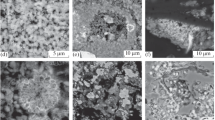Abstract
The aragonite constructions of the Black Sea are formed in a stable anaerobic zone and are a perfect object to study the natural mechanism of anaerobic methane oxidation. The most probable pathway of methane oxidation is its methanogen-mediated reaction with bicarbonates, dissolved in seawater, with the formation of water and acetate, which is then consumed by other components of the anaerobic community. Comparison of the δ13C values of carbonate minerals and organic matter once more demonstrated that the formation of the organic matter of biomass is accompanied by intense fractionation of carbon isotopes, as a result of which the total organic matter of biomass acquires an extremely light isotopic composition, characterized by δ13C values as low as –83.8‰.
Similar content being viewed by others
REFERENCES
Lein, A.Yu., Logvinenko, N.V., Volkov, I.I., et al., Mineral and Isotopic Composition of Diagenetic Carbonate Minerals of the Concretions from Reduced Sediments of the Gulf of California, Dokl. Akad. Nauk SSSR, 1975, vol. 224, no. 2, pp. 426–429.
Lein, A.Yu., Gorshkov, A.I., Pimenov, N.V., et al., Autigenic Carbonates on Methane Seeps in the Norwegian Sea: Mineralogy, Geochemistry, and Genesis, Litol. Polezn. Iskop., 2000, no. 4, pp. 339–354.
Molismologiya Chernogo morya (Molismology of the Black Sea), Polikarpov, G.G., Ed., Kiev: Naukova Dumka, 1992.
Ivanov, M.V., Polikarpov, G.G., Lein, A.Yu., et al., Biogeochemistry of the Carbon Cycle in the Zone of Black Sea Methane Seeps, Dokl. Akad. Nauk SSSR, 1991, vol. 320, pp. 1235–1240.
Pimenov, N.V., Rusanov, I.I., Poglazova, M.N., et al., Bacterial Mats on Coral-like Structures at Methane Seeps in the Black Sea, Mikrobiologiya, 1997, vol. 66, pp. 421–428.
Zehnder, A.J.B. and Brock, T.D., Methane Formation and Methane Oxidation by Methanogenic Bacteria, J. Bacteriol., 1979, vol. 39, pp. 420–432.
Zehnder, A.J.B. and Brock, T.D., Anaerobic Methane Oxidation: Occurrence and Ecology, Appl. Environ. Microbiol., 1980, no. 3, pp. 194–204.
Tourova, T.P., Kolganova, T.P., Kuznetsov, K.B., and Pimenov, N.V., Phylogenetic Diversity of the Archaeal Component of Bacterial Mats on Coral-like Structures in Zones of Methane Seeps in the Black Sea, Mikrobiologiya, 2002 (in press).
Valentine, D.L. and Reeburgh, W.S., New Perspectives on Anaerobic Methane Oxidation (Mini Review), Environ. Microbiol., 2000, vol. 2, no. 5, pp. 477–484.
Esikov, A.D., Mass-spektrometricheskii analiz prirodnykh vod (Mass-Spectrometric Analysis of Natural Waters), Moscow: Nauka, 1980.
Kuznetsov, V.M., Absolyutnaya geokhronologiya donnykh osadkov okeanov i morei (Absolute Geochronology of Bottom Sediments of Oceans and Seas), Moscow: Nauka, 1986.
Kulebyakina, L.G. and Zesenko, A.Ya., Dynamics of the Levels of Contamination of the Black Sea Water and Hydrobionts with 90Sr and 137Cs, Morskaya radiokhemoekologiya i problema zagryaznenii (Marine Radio-chemoecology and the Contamination Problem), Kiev: Naukova Dumka, 1984, pp. 16–40.
Polikarpov, G.G., Egorov, V.N., Nezhdanov, A.I., et al., The Phenomenon of Active Gas Seepage from the Elevations in the Zone of Transition from Open Shelf to Continental Slope in the Western Part of the Black Sea, Dokl. Akad. Nauk USSR, 1989, no. 1, pp. 13–15.
Domanov, M.M., Kontar', E.A., Kos'yan, R.D., et al., Anthropogenic Radionuclides in Bottom Sediments in the Northwestern Zone of the Black Sea, Okeanologiya (Moscow), 1996, no. 4, pp. 550–556.
Lein, A.Yu., On the Gas Seeps and the Nature of Carbonate Constructions at the Bottom of the Black Sea, Tez. dokl. 3-go Vsesoyuznogo Soveshchaniya po geokhimii ugleroda 9-11 dekabrya 1991 g., Moskva (Abstr. 3rd All-Union Conf. on the Geochemistry of Carbon, Dec. 9-11, 1991, Moscow), vol. 1, pp. 146–147.
Ul'yanova, N.V., Lein, A.Yu., and Miller, Yu.M., Mineralogical and Geochemical Characteristics of the Carbonate Constructions in the Zones of Gas Seeps at the Bottom of the Black Sea, Tez. dokl. 11 Mezhdunarodnoi shkoly morskoi geologii, 1995, Moskva (Abstr. 11th Int. Courses on Marine Geology, 1995, Moscow), vol. 1.
Lein, A.Yu., Gal'chenko, V.F., and Pokrovskii, B.G., Marine Carbonate Concretions as a Result of the Process of Microbial Oxidation of Gas-Hydrate Methane in the Sea of Ohkotsk, Geokhimiya, 1989, no. 10, pp. 1396–1406.
Von Rad, U., Rosch, H., Berner, U., et al., Autigenic Carbonates Derived from Oxidized Methane Vented from the Makran Accretionary Prism off Pakistan, Mar. Geol., 1996, vol. 136, pp. 55–57.
Ivanov, M.V., Belyaev, S.S., Zyakun, A.M., et al., Carbon Stable Isotopes Fractionation by Methane-Producing Bacteria Growing on Different Substrates, Isotopes in der Nature, Leipzig, 1983, pp. 139–158.
Methane Gas Seep Explorations in the Black Sea (MEGASEEBS), Project Report, Berichte aus dem Zentrum fur Meers-und Klimatforschung, Universitat Hamburg, E 14, 1998.
Alperin, M.J. and Reeburgh, W.S., Geochemical Observations Supporting Anaerobic Methane Oxidation, Microbial Growth on C-1 Compounds, Crawford, R.L. and Hanson, R.S., Eds., Washington: Am. Soc. Microbiol., 1985, pp. 282–289.
Barnes, R.O. and Goldhaber, L.D., Methane Production and Consumption in Anoxic Marine Sediments, Geology, 1976, vol. 4, pp. 1977–1984.
Reeburgh, W.S., Methane Consumption in Cariaco Trench Waters and Sediments, Earth Planet. Sci. Lett., 1976, vol. 28, pp. 337–344.
Reeburgh, W.S. and Heggie, D.T., Microbial Methane Consumption Reactions and Their Effect on Methane Distributions in Freshwater and Marine Environments, Limnol. Oceanogr., 1977, no. 22, pp. 1–9.
Thiel, V., Peckmann, J., Reitner, J., et al., Highly Isotopically Depleted Isoprenoids-Molecular Markers for Ancient Methane Venting, Geochim. Cosmochim. Acta, 1999, vol. 63, pp. 3959–3966.
Nikolaev, S.D., Izotopnaya paleogeografiya vnutrikontinental'nykh morei (Isotopic Paleogeography of Intracontinental Seas), Moscow: VNIIRO, 1995.
Swart, P.K., The Oxygen and Hydrogen Isotopic Composition of the Black Sea, Black Sea Oceanography, Murrey, G.W., Ed., Deep-Sea Res., 1991, vol. 38, Suppl. Issue no. 2A, pp. 761–772.
Grinenko, V.A. and Ustinov, V.I., Peculiarities of Formation of the Isotopic Composition of Sulfate Oxygen and Sulfur during Bacterial Sulfate Reduction (by the Example of the Black Sea and Sivash), Geokhimiya, 1996, no. 8, pp. 907–909.
Author information
Authors and Affiliations
Rights and permissions
About this article
Cite this article
Lein, A.Y., Ivanov, M.V., Pimenov, N.V. et al. Geochemical Peculiarities of the Carbonate Constructions Formed during Microbial Oxidation of Methane under Anaerobic Conditions. Microbiology 71, 78–90 (2002). https://doi.org/10.1023/A:1017906501726
Issue Date:
DOI: https://doi.org/10.1023/A:1017906501726




